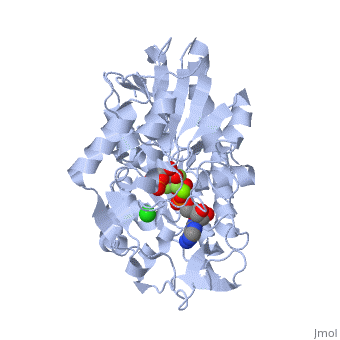| Structural highlights
2y3i is a 2 chain structure with sequence from Homo sapiens. Full crystallographic information is available from OCA. For a guided tour on the structure components use FirstGlance.
| | Method: | X-ray diffraction, Resolution 2.9Å |
| Ligands: | , , , , |
| Resources: | FirstGlance, OCA, PDBe, RCSB, PDBsum, ProSAT |
Disease
PGK1_HUMAN Defects in PGK1 are the cause of phosphoglycerate kinase 1 deficiency (PGK1D) [MIM:300653. It is a condition with a highly variable clinical phenotype that includes hemolytic anemia, rhabdomyolysis, myopathy and neurologic involvement. Patients can express one or more of these manifestations.[1] [2] [3] [4] [5] [6] [7] [8] [9]
Function
PGK1_HUMAN In addition to its role as a glycolytic enzyme, it seems that PGK-1 acts as a polymerase alpha cofactor protein (primer recognition protein).
Publication Abstract from PubMed
Substrate antagonism has been described for a variety of enzymes with more than one substrate and is characterized by a lowering of the affinity of one substrate in the presence of the other(s). 3-Phosphoglycerate kinase (PGK) catalyzes phosphotransfer from 1,3-bisphosphoglycerate (bPG) to ADP to give 3-phosphoglycerate (PG) and ATP, and is subject to substrate antagonism. Because of the instability of bPG, antagonism has only been described between PG and ATP or ADP. Here, we show that antagonism also occurs between bPG and ADP. Using the stopped-flow method, we show that the dissociation constant for one substrate increases in the presence of the other, and that this decrease in affinity is mainly due to an increase in the dissociation rate constant. As a consequence, there is an increase in the overall interaction kinetics. Interestingly, in the presence of the mirror image of natural d-ADP, l-ADP (a good substrate for PGK), antagonism is absent. Using rapid-quench-flow, we studied the kinetics of ATP formation. The time courses present the following: (1) a lag with l-ADP, but not with d-ADP, the kinetics of which were similar to the interaction kinetics measured by stopped-flow; (2) a burst that is directed by the phosphotransfer; and (3) a steady-state that is rate limited by the release of product kinetics. Structural explanations for these results are proposed by analyzing the crystallographic structure of the fully closed conformation of PGK in complex with l-ADP, PG, and the transition-state analogue AlF(4)(-) compared to previously determined structures.
Interaction of human 3-phosphoglycerate kinase with its two substrates: is substrate antagonism a kinetic advantage?,Lallemand P, Chaloin L, Roy B, Barman T, Bowler MW, Lionne C J Mol Biol. 2011 Jun 24;409(5):742-57. Epub 2011 Apr 27. PMID:21549713[10]
From MEDLINE®/PubMed®, a database of the U.S. National Library of Medicine.
See Also
References
- ↑ Yoshida A, Twele TW, Dave V, Beutler E. Molecular abnormality of a phosphoglycerate kinase variant (PGK-Alabama). Blood Cells Mol Dis. 1995;21(3):179-81. PMID:8673469 doi:S1079-9796(85)70020-4
- ↑ Cohen-Solal M, Valentin C, Plassa F, Guillemin G, Danze F, Jaisson F, Rosa R. Identification of new mutations in two phosphoglycerate kinase (PGK) variants expressing different clinical syndromes: PGK Creteil and PGK Amiens. Blood. 1994 Aug 1;84(3):898-903. PMID:8043870
- ↑ Ookawara T, Dave V, Willems P, Martin JJ, de Barsy T, Matthys E, Yoshida A. Retarded and aberrant splicings caused by single exon mutation in a phosphoglycerate kinase variant. Arch Biochem Biophys. 1996 Mar 1;327(1):35-40. PMID:8615693 doi:http://dx.doi.org/10.1006/abbi.1996.0089
- ↑ Valentin C, Birgens H, Craescu CT, Brodum-Nielsen K, Cohen-Solal M. A phosphoglycerate kinase mutant (PGK Herlev; D285V) in a Danish patient with isolated chronic hemolytic anemia: mechanism of mutation and structure-function relationships. Hum Mutat. 1998;12(4):280-7. PMID:9744480 doi:<280::AID-HUMU10>3.0.CO;2-V 10.1002/(SICI)1098-1004(1998)12:4<280::AID-HUMU10>3.0.CO;2-V
- ↑ Maeda M, Yoshida A. Molecular defect of a phosphoglycerate kinase variant (PGK-Matsue) associated with hemolytic anemia: Leu----Pro substitution caused by T/A----C/G transition in exon 3. Blood. 1991 Mar 15;77(6):1348-52. PMID:2001457
- ↑ Maeda M, Bawle EV, Kulkarni R, Beutler E, Yoshida A. Molecular abnormalities of a phosphoglycerate kinase variant generated by spontaneous mutation. Blood. 1992 May 15;79(10):2759-62. PMID:1586722
- ↑ Fujii H, Kanno H, Hirono A, Shiomura T, Miwa S. A single amino acid substitution (157 Gly----Val) in a phosphoglycerate kinase variant (PGK Shizuoka) associated with chronic hemolysis and myoglobinuria. Blood. 1992 Mar 15;79(6):1582-5. PMID:1547346
- ↑ Fujii H, Chen SH, Akatsuka J, Miwa S, Yoshida A. Use of cultured lymphoblastoid cells for the study of abnormal enzymes: molecular abnormality of a phosphoglycerate kinase variant associated with hemolytic anemia. Proc Natl Acad Sci U S A. 1981 Apr;78(4):2587-90. PMID:6941312
- ↑ Fujii H, Yoshida A. Molecular abnormality of phosphoglycerate kinase-Uppsala associated with chronic nonspherocytic hemolytic anemia. Proc Natl Acad Sci U S A. 1980 Sep;77(9):5461-5. PMID:6933565
- ↑ Lallemand P, Chaloin L, Roy B, Barman T, Bowler MW, Lionne C. Interaction of human 3-phosphoglycerate kinase with its two substrates: is substrate antagonism a kinetic advantage? J Mol Biol. 2011 Jun 24;409(5):742-57. Epub 2011 Apr 27. PMID:21549713 doi:10.1016/j.jmb.2011.04.048
|

